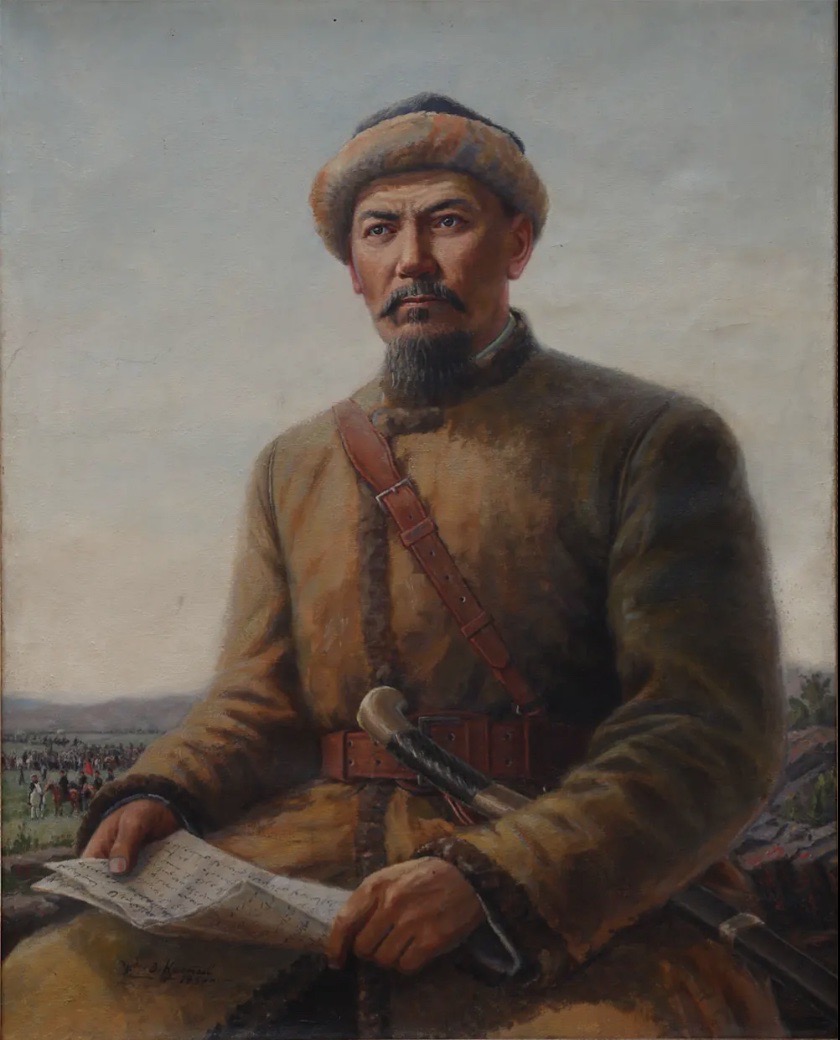ASTANA – Kazakhstan is celebrating the 150th anniversary of Amangeldi Imanov, the leader of the 1916 national liberation uprising against the Tsarist rule, who became a symbol of resistance to social oppression during the power transition period of the early 20th century.

Amangeldi Imanov painted by Abilkhan Kasteev in 1950. Photo credit: arthive.com.
Imanov took a passionate stance against both the colonial policy of the tsarist government and the feudal power of local bays (wealthy elite), who he believed were sold out to the tsarist powers.
Born to a lower-class family in 1873, Imanov contemplated Kazakh people’s poverty, vowing to fight and change the oppression of the colonial regime, convinced of the anti-people nature of the Russian tsarist power.
Led by liberation ideas of the first Russian revolution of 1905-1907, he took part in an armed struggle of the poor against the bays. Having established close ties with a group of Bolsheviks, Imanov became famous throughout the Turgai steppe in central parts of Kazakhstan as an organizer of the national liberation struggle of the peasant masses for which he was serially imprisoned during 1896-1908.
Imanov was a typical representative of the Kazakh sharua (working) class. Due to his active participation in the public life of the auyls (villages), he stood at the forefront of the liberation movement that began in 1916 in Kazakhstan and Central Asia.
The main factor that triggered the uprising was Nicholai II’s imperial decree to mobilize the non-native male population of Kazakhstan, Central Asia, and parts of Siberia aged 19 to 43 for rear work on the construction of fortifications during World War I.
The decree gave the Kazakh population an urgent reason to protest against the government’s plan to relieve Russian soldiers from this rear work, replacing them with requisitioned non-natives.
Nearly half a million people were to be deployed from Kazakhstan and Central Asia. In July 1916, spontaneous protests began in almost all regions of Kazakhstan, quickly growing into an armed uprising.
Imanov was the hallmark of the revolution and showed himself to be a true fighter.
He fought tirelessly against tremendous odds, consequently achieving an astonishing degree of influence among the people. His army of sarbaz (soldiers) reached 50,000 in over 20 units formed in Torgai and Irgiz districts in central Kazakhstan.
The operation demonstrated Imanov’s organizational and military talents. He established strict discipline in the detachments, taught the rebels to use weapons, and demanded to learn combat rules. The insurgents organized several attacks against the local authorities of the royal power surrounding the town of Torgai.
Military writer Leonid Sobolev, who studied the uprising in the 1930s, described his army as “strange.” “As if it had come out of fables and tales, with pikes and sabers forged by village smiths, fused guns, bows, and arrows,” he wrote.
Gradually the armed uprising became a guerrilla war, and clashes with the tsarist troops continued until the February Revolution in 1917.
Behind the fierce image lies the reality of a man whose vision of liberation was ruthless but also personal and compassionate towards common people.
“Evil people, your and our enemies, have started a rumor that we, who rebelled for our rights, would kill all Russians. This is a lie. We are not at war with the working Russian people. We are at war with the Tsar, with the Tsarist order, with the wealthy elite and mullahs, who have sold us to the Tsar and are shedding our blood. Do not believe the evil rumors!” reads one of Imanov’s known appeals to people.
In later years, Imanov participated in the establishment of Soviet power in the Torgai Region, nowadays the Kostanai Region, and was a military commissar of the Torgai district.
He formed the first national Red Army units in Kazakhstan with another revolutionary, Alibi Zhangeldin. After the liquidation of Soviet power in Torgai in April 1919, Imanov was taken prisoner and later killed.
The life and struggle of Imanov were reflected in the writer Gabit Musrepov’s “Amangeldi” play and Moisei Levin’s film of the same name in 1938. No lifetime photos of Imanov have been preserved. Later, folk artists Abilkhan Kasteev and Kanafiya Telzhanov created the image of the hero in the fine arts.

